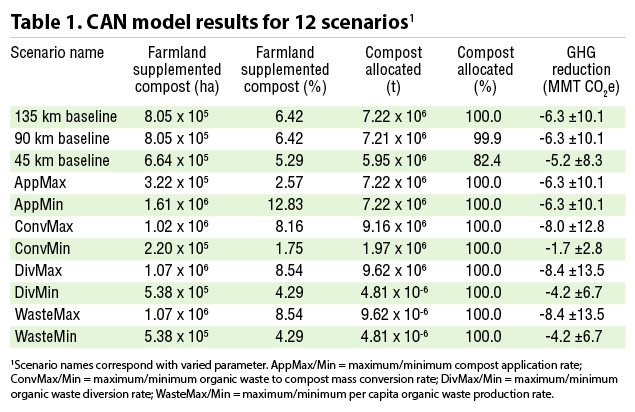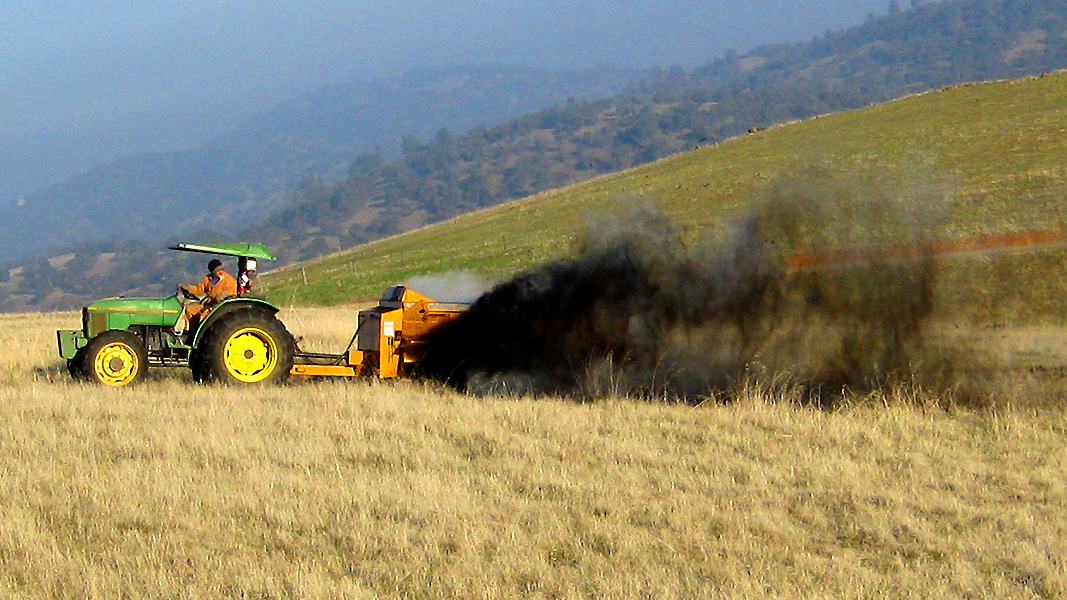Brendan Harrison
In an effort to reduce methane emissions from landfills and increase organics recycling, California Governor Jerry Brown signed into law SB 1383 in 2016. This landmark law has an end goal of reducing landfill disposal of organic waste by 75% below 2014 levels by 2025 (Lara, 2016). To meet this goal, California must significantly expand its organics recycling capacity, and likely will rely on aerobic composting as a primary method for managing this diverted waste (CalRecycle, 2019).
Clearly, composting has the potential to offer many environmental and agricultural benefits. However, some have questioned whether composting makes sense, from both an environmental and an economic perspective, when compost must be transported long distances to end markets by large fossil-fuel burning trucks. This is especially concerning when considering urban areas like Los Angeles where a great amount of organic waste is produced, but little farmland exists nearby for compost application.
In our recent study published in Environmental Science & Technology, my co-authors and I investigated whether, for each city in California, composting is a feasible strategy for meeting SB 1383 diversion goals when considering the distance that compost must be transported from city to farm (Harrison, et al, 2020). To answer this question, we developed a computer model called the Compost Allocation Network (CAN) that simulates a statewide composting system in which all of the organic waste that is diverted from landfills under SB 1383 is composted and applied to farmland. We found that even when the distance that compost can be transported is limited by economic and environmental factors, enough farmland exists near every city in California for the distribution of 100% of SB 1383 diverted organic waste as compost.
Methods
To get started, we estimated the area of farmland that each California city could amend with compost. The amount of organic waste that each city produces was estimated from city population and per capita waste rates, and we assumed that 75% of each city’s organic waste was converted into compost and could be applied to farmland at a rate of 9 metric tons per hectare.
After calculating how much farmland each city could theoretically apply compost to, we estimated how far compost could be transported from city to farm. Because the goal of SB 1383 is to reduce the state’s climate impact, strategies to help meet this goal must reduce greenhouse gases (GHGs). Composting generally reduces GHGs by reducing landfill methane emissions and by sequestering carbon. However, we wanted to test whether compost still reduced GHG emissions even when it was transported very long distances.
This was assessed by conducting a Life Cycle Assessment (LCA) that took into consideration the total life cycle of compost, beginning with transportation of organic waste to composting facilities and ending with its decomposition in soil at a farm. For each stage of the life cycle, the GHG emissions that would be produced were estimated, and then all the emissions and reductions were added together to get the total global warming impact (GWP) of the composting life cycle. This enabled us to find the maximum distance that compost could be transported while still reducing GHGs overall.
In addition to reducing emissions, strategies that help meet SB 1383 should also be economically feasible. In our study, we assumed that compost could become too expensive for a farmer to purchase if it is transported too far. To get some insight into how much farmers would be willing to invest in purchasing, transporting, and applying compost, we interviewed three California compost companies from different regions of the state. From these interviews, we estimated the maximum price that farmers would be willing to pay for compost. Then, we solved for the maximum distance that compost could be transported before total expenses become greater than the “willingness to pay” cost.
Once we had the area of farmland where each California city could apply compost and the maximum distance that compost could be transported, we developed the Compost Allocation Network (CAN) model to simulate a statewide composting system. First, mapping software was used to create a map of all California cities and farms. For each city, we took our estimate of the area of farmland that it could cover with compost, and then used the model to distribute the city’s compost to nearby farmland, starting with the closest farm. Once the nearest farm’s compost use capacity is met, the model then begins allocating compost to the next nearest farm, and the process continues until all of the city’s compost is distributed or until there are no more farms close enough to where the compost can be transported.
When modeling, it is important to consider various scenarios that predict what the future might look like. For this paper, 11 different scenarios were tested (Table 1). This included three baseline scenarios that all use the same “best guesses” for items like compost generation and application rate, but that differ in how far they allow compost to be hauled from city to farm. For the other eight scenarios, we took our “best guesses” and varied one of these key parameters, such as compost application rate. We gave these eight scenarios names like “AppMax” that correspond to the varied parameter (AppMax uses maximum application rate).
Results/Discussion
When considering how far compost could be transported from city to farm, we found distance to be constrained by economics and not emissions. In fact, due to the great climate benefits associated with reducing landfill methane emissions and sequestering carbon in soil, we found that one metric ton of compost could be transported up to 8,300 km without becoming a net source of GHG emissions. On the other hand, because compost is expensive to transport, we found that it could be transported up to 135 km and remain cost-effective for farmers to purchase. We used this shorter distance as the maximum distance that compost could be transported from city to farm in our CAN model. We also tested two shorter distances, 90 km and 45 km, to investigate the potential of limiting compost distribution to even shorter distances.
 For all scenarios that used a 135 km transportation distance, 100% of the compost produced in every city could be distributed to farmland. Even cities in Los Angeles County were able to transport all of their compost to farmland, and this was due, in part, to the southern most Central Valley farmland existing within 135 km of many of these cities. When the maximum distance was shortened to 90 km, 99.9% of compost was able to be distributed to farmland, while 82.4% of compost could be applied when hauled up to 45 km (Table 1). In the 45 km scenario, 83 of the 98 cities that were not able to distribute all of their compost were located in either Los Angeles or Orange counties (Figures 1 and 2).
For all scenarios that used a 135 km transportation distance, 100% of the compost produced in every city could be distributed to farmland. Even cities in Los Angeles County were able to transport all of their compost to farmland, and this was due, in part, to the southern most Central Valley farmland existing within 135 km of many of these cities. When the maximum distance was shortened to 90 km, 99.9% of compost was able to be distributed to farmland, while 82.4% of compost could be applied when hauled up to 45 km (Table 1). In the 45 km scenario, 83 of the 98 cities that were not able to distribute all of their compost were located in either Los Angeles or Orange counties (Figures 1 and 2).

 Our model assumes that farmers pay the full price of purchasing, transporting, and applying compost. However, some farmers will likely receive financial assistance when purchasing compost through programs such as the California Department of Food and Agriculture’s Healthy Soils Program, which could allow compost to be transported even further (CDFA, 2019). For example, in the 90 km scenario, the city of Arcata lacks enough farmland nearby to distribute all of its compost. However, if subsidies offsetting $31.50/metric ton of shipped and applied compost were offered, then it would be cost-effective for farmers to ship the compost the additional 20 km needed to reach their farms. Furthermore, it is likely that cities will not rely entirely on composting to manage their diverted organic waste as strategies such as anaerobic digestion exist and offer enticing co-benefits such as renewable energy generation.
Our model assumes that farmers pay the full price of purchasing, transporting, and applying compost. However, some farmers will likely receive financial assistance when purchasing compost through programs such as the California Department of Food and Agriculture’s Healthy Soils Program, which could allow compost to be transported even further (CDFA, 2019). For example, in the 90 km scenario, the city of Arcata lacks enough farmland nearby to distribute all of its compost. However, if subsidies offsetting $31.50/metric ton of shipped and applied compost were offered, then it would be cost-effective for farmers to ship the compost the additional 20 km needed to reach their farms. Furthermore, it is likely that cities will not rely entirely on composting to manage their diverted organic waste as strategies such as anaerobic digestion exist and offer enticing co-benefits such as renewable energy generation.
The CAN model results suggest that composting can be a viable strategy for meeting SB 1383 organics diversion goals for cities across California. Even cities in Los Angeles County are unlikely to face significant distribution issues since enough farmland exists nearby for compost distribution. However, California does not currently have the composting infrastructure needed for a statewide composting system. With significant investment in the state’s organics recycling industry, 75% organic waste diversion could be achieved and become an example to other regions interested in developing their own regional composting systems.
Brendan Harrison is a PhD student at the University of California Merced Environmental Systems graduate group. His research interests include climate solutions at the intersection of food and waste systems, climate justice, and circular economies. Brendan’s dissertation research will investigate how biochar influences nitrogen cycling when co-composted with dairy manure.













